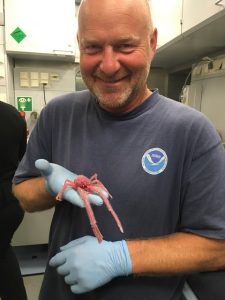Discovering Deep-Sea Corals of the Phoenix Island Seamounts
Three coral-invertebrate associations observed here in the Phoenix Islands include:
Species of squat lobster crabs of the family Chirostylidae we encountered at Kanton Atoll living within the branches of a Chrysogorgia, a genus of soft octocoral. While we only observed one individual in this particular coral example, we have observed similar squat lobsters populating other chrysogorgid corals in what may be considered a family unit, with adults (some carrying eggs) and small squat lobsters living within the same coral colony. While the crabs may find protection from predators and feed on organic particles captured by the coral, it is unclear whether or not the coral benefits from hosting these crabs.
 Brittle stars wrap into their host coral (here a plexaurid coral), sometimes extending the tips of their arms out into the water column to catch food particles that drift by in the current. Corals and brittle stars may have a mutualistic relationship in which both organisms find benefit from their interactions- the coral receiving protection from predators and the brittle star, branching surfaces on which to capture organic particles for food. Be on the lookout for these interesting echinoderms with their arms wrapped tightly in the branching corals, and see if other associates are living with them on the same coral.
Brittle stars wrap into their host coral (here a plexaurid coral), sometimes extending the tips of their arms out into the water column to catch food particles that drift by in the current. Corals and brittle stars may have a mutualistic relationship in which both organisms find benefit from their interactions- the coral receiving protection from predators and the brittle star, branching surfaces on which to capture organic particles for food. Be on the lookout for these interesting echinoderms with their arms wrapped tightly in the branching corals, and see if other associates are living with them on the same coral.
Some sea stars are coral predators, working their way over the branches of a coral, often everting their stomachs to consume live tissue. On a seamount southwest of Kanton Island, we discovered that this sea star had apparently consumed a portion of a bamboo coral. Bamboo corals are a type of deep-water coral with a light skeleton and dark flexible proteinaceous nodes that are characteristic of the Isisidae family. Here we can see a close up view of these nodes since the sea star has cleared the tissue.
While squat lobsters, brittle stars and sea stars represent three of the more prominent coral associates, we will encounter a diverse array of animals that live on corals. If you tune into our live stream on YouTube, you are likely to see smaller crustaceans, such as amphipods (maintaining reproductive houses) and mysid shrimp (swimming just above the coral tips), and polychaete worms that call deep-sea corals home. While corals, in their shapes and colors, are truly magnificent, a closer look reveals diverse charismatic animals that call these corals home.
We are documenting and sampling the diverse inhabitants of deep water corals in the Phoenix Island Protection Area. In our lab at the Woods Hole Oceanographic Institution, we will: 1) identify invertebrate-symbiont species associations through genetic barcoding and morphological assessments of the coral associates; 2) examine the composition of host and associates with habitat, depth, geographic location, fidelity and ecological function, and add our observations to a global biogeographic database, and 3) categorically analyze the ecological function (e.g., predation, protection, parasitism), and relationship fidelity (e.g., facultative, obligate, commensalism, paratization) in order both to understand how deep water corals and their diverse associates have evolved their amazing relationships and provide critical information for the management of the deep waters of the Phoenix Islands Protected Area.
